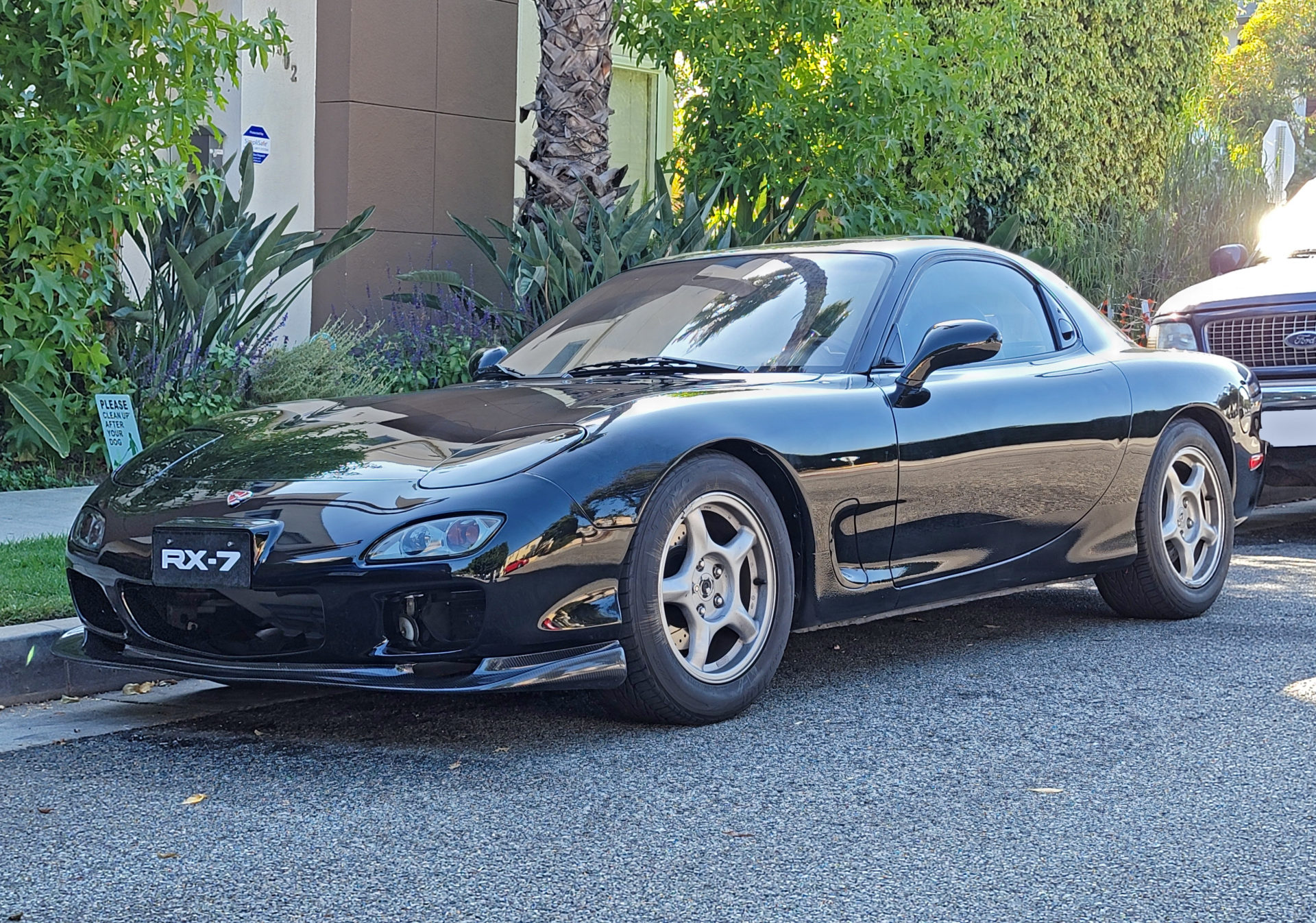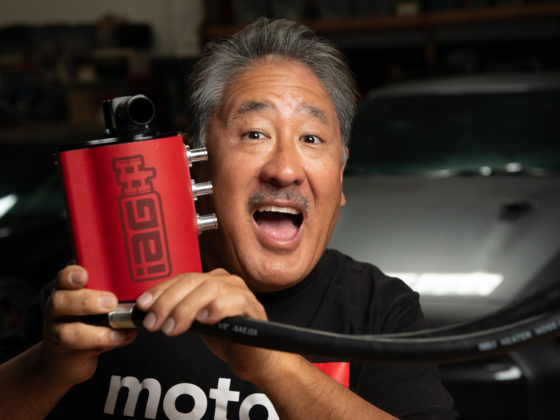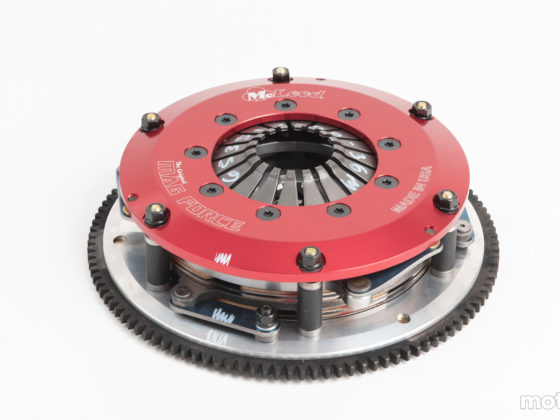 To further make this car period-correct, an Apexi turbo timer was also installed. These were popular decades ago to keep the engine running for a minute or so, in order to circulate water and oil through the turbo after removing the key from the car. You know, because in the 90’s and 2000’s, no one had time for a cooldown lap on the track and it was common to immediately shut a car off after doing a pull on the street. (Sarcasm).
To further make this car period-correct, an Apexi turbo timer was also installed. These were popular decades ago to keep the engine running for a minute or so, in order to circulate water and oil through the turbo after removing the key from the car. You know, because in the 90’s and 2000’s, no one had time for a cooldown lap on the track and it was common to immediately shut a car off after doing a pull on the street. (Sarcasm).
 It was probably a good idea for the previous owner to install a fire extinguisher in a modified turbocharged ‘tuner’ car. While RX-7s don’t seem to catch fire as often as some modern exotic cars, as backyard and shade-tree mechanics modify and install new parts, the likelihood that the labor and/or the parts aren’t up to OEM standards and the risk of failures and fires does increase. There really are no downsides for having fire protection in a modified car or one that’s driven hard.
It was probably a good idea for the previous owner to install a fire extinguisher in a modified turbocharged ‘tuner’ car. While RX-7s don’t seem to catch fire as often as some modern exotic cars, as backyard and shade-tree mechanics modify and install new parts, the likelihood that the labor and/or the parts aren’t up to OEM standards and the risk of failures and fires does increase. There really are no downsides for having fire protection in a modified car or one that’s driven hard.
 The engine bay is where most of the RX-7’s magic and disasters are located. Right before this car was sold, a few modifications to the engine were made. Most notably is the highly problematic ebay intercooler that was installed. We will cover this in close detail in the future but in short, without proper ducting the radiator was fed by the hot exhaust-wash from the radiator; resulting in intake temps higher than the stock intercooler!!! Modifications like this greatly hurt the performance and reliability of the rotary engine.
The engine bay is where most of the RX-7’s magic and disasters are located. Right before this car was sold, a few modifications to the engine were made. Most notably is the highly problematic ebay intercooler that was installed. We will cover this in close detail in the future but in short, without proper ducting the radiator was fed by the hot exhaust-wash from the radiator; resulting in intake temps higher than the stock intercooler!!! Modifications like this greatly hurt the performance and reliability of the rotary engine.
Other modifications include twin HKS foam air filters, larger alternator and water pump pullies, and an aluminum radiator dress-up panel.
 For being nearly 30 years old, the FD RX-7’s specs still showcase well against newer and modern front-engine, rear-drive favorites like the Honda S2000, GT86 of the BRZ/FRS, and the Mazda (ND) Miata
For being nearly 30 years old, the FD RX-7’s specs still showcase well against newer and modern front-engine, rear-drive favorites like the Honda S2000, GT86 of the BRZ/FRS, and the Mazda (ND) Miata
At 69.3” wide and 48.4” high, the RX-7 has excellent proportions and is actually shorter and wider than an S2000 by 2.2” and 0.4” respectively. Compared to an ND Miata, the RX-7 is surprisingly 0.2” shorter and 1.2” wider. Compared to a GT86/BRZ/FRS; the RX7 is 2.2” shorter but 0.6” narrower
 I would say specification wise, the RX-7 best stacks up against the S2000. But at 255 HP and 217lb-ft of torque, the RX-7 bests the S2000 by 15hp and a whopping 56lb-ft of torque while weighing more than 100lbs less.
I would say specification wise, the RX-7 best stacks up against the S2000. But at 255 HP and 217lb-ft of torque, the RX-7 bests the S2000 by 15hp and a whopping 56lb-ft of torque while weighing more than 100lbs less.
Overall, I’m super excited to be consulting on the build of this FD Mazda RX-7. Next to our own Project NSX, the RX-7 has always been one of my favorite JDM cars from the 90’s, and also one of the best “Driver’s Cars”. Be sure to stay tuned as I show the proper steps to make these cars reliable, faster, and elevated to “OEM-Plus” levels in this resto-modded FD.




26 comments
Sweet! I’ll keep my eye on this one, this one should turn out a killer!
I’ve had my 1993 since 1998. I bought it with 12,000 miles and just hit 180,000 yesterday. Best money I ever spent. It is on engine number two fir anyone wondering…
Thanks for the great photos and write-up. I will live vicariously through this build.
As a fellow rotor head and FD owner, i am very excited for this build. I am currently working on improving my car so that it can better perform at the track and give that OEM + feeling while driving it on the street.
i also work at Ford and had the pleasure of working on both the Voodoo and GT500 engines. I’m excited to see what this FD can do with Billy behind the wheel.
Way cool! We sort have somewhat worked together on those awesome products! Stay tuned to see the path I am choosing to make this car more reliable faster, and more refined!
This is going to be epic! We still need NSX and Viper updates, too…
Thanks, stay tuned. More NSX content should drop next week!
Looking forward to the updates on this car, especially after it featured in a video elsewhere.
Great to hear! Yes, and we will cover all of the things that happened to the car before that video was shot 🙂
Be interested to see your take on things; the car looks like a decent starting point and there’s a lot of really interesting options for drivable, reliable power on these cars nowadays. Not that I’m a Mazda fanboy or anything (OK, I am) but it’s really nice to see an OEM do stuff where so many of the fundamentals are basically right.
It really is a great starting point. Miatas are such good sports cars and the RX-7 takes that to another level in terms of chassis stiffness, power, and torque. Mazda has always been sports-car and driver-focused and the FD RX-7 IMO is one of the best cars they ever made. This is going to be a lot of fun working with this car.
“Series 8 (produced from 1998 to 2002) was the final series, and was only available in the Japanese market. More efficient turbochargers were available on certain models, while improved intercooling and radiator cooling was made possible by a redesigned front fascia with larger openings.”
Is it possible to get parts from these last models? Seeing how this is a ‘restomod.’
This car already has the Series 8 (“99+”) front bumper. Everything else will be upgraded.
I had and FD for a little over 5 years and the last couple years of ownership I tracked it almost once a month. I loved that car, it was reliable, made decent power and handled really well. I’m actually more paranoid about my current stock engine S2000 blowing than I was about my FD lol. If I had the money, space (and wife’s approval) for a dedicated track car it would 100% be an FD.
Those are both great cars. I’m actually going to do a track comparison of the S2K vs the FD. Stick around!
Go with Polymetal Grey and the ND Miata Dash
Love the way you lay things out in your write ups. Very analytical without being too wordy.
We’ve had a few theories on heat management as well as practical results on these motors after applying both Deep Cryo and WPC to race rotaries . We believe that thermal dispersants and thermal barriers should be tested and applied on internal components in key locations. Of course along with DCT and WPC as major contributors to longevity and performance gains. 😇
Thank you, that’s what I strive for in my articles. What components have you had success with cryo, WPC treating, and coating?
All internals really for the WPC and Cryogenics. The rotors and select areas in the motor for the coatings. We can discuss in person if you like…. Hit up Martin to Mike for our contact info.
Love the FD….. I ended up with Project S2000 because I needed a reliable daily driver. You’ll have to drive it after it’s boosted. I FINALLY have a timeline for dropping it off to get the fab work done. I was talking with my coworker Billy J today and it sounds like he’s got his S2k lined up for the track comparison with you. Gonna be fun to watch!
I’ll look forward to that 🙂 Have him hit me up, I think I lost his contact info.
Can’t wait for the FD vs S2K comparison. Having driven both, the cars’ development goals are obvious from behind the wheel. The S2000 was built for driving pleasure, with maximum performance a secondary consideration, whereas the FD was built as an all-out performance machine to take on the fastest sports cars of the day. On track I think the FD will ultimately be faster due to its superior aerodynamics, lower CoG, and longer wheelbase. The S2000 offers maximum driving enjoyment though with its refined inputs, and the shifter feel and throttle response are immediate in a way that the FD is not.
That radio was pretty decent back in the day. Time alignment, 3-way crossover and the ability to control multiple (!) disc changers. Ok, so maybe the last feature isn’t that great. But it will probably bring a couple hundred bucks on eBay or DIYMobileAudio
Thanks! I’ll look into that when the head unit is replaced. The far bigger issue is what was done to the speakers.
I loved my 93, and I’m anxious to follow your build, as I did with Dave Coleman’s articles in “Sport Compact Car” to guide me through my mods. As you mentioned, I took care of overheating at the track with all front “mouth” air being fully ducted to the upgraded intercooler, and the intake air taken in from a separate side opening. I do feel it’s confusing to liken this engine to a 2 stroke, given the fact that it is a 4 stroke engine that lacks the 2-stroke porting that interrupts the cycles near BDC.
This looks like a great build. I myself have a 93 black FD as well and fully built…so I’ll be interested in the updates!